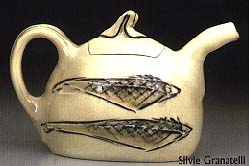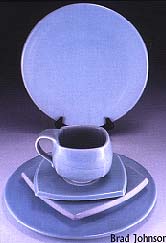

May Issue 2000
A Touch of Porcelain A National Exhibit
by Susan Filley
Elegance - the unifying element of the exhibition A Touch of Porcelain held in Denver, Colorado during the NCECA conference, "Higher Ground". Curated by Susan Filley, of Charleston, SC and Matt Long, of Gainesville, FL, the exhibition includes 22 national artists and over 100 pieces of work. The show was hosted by Red Rocks Community College with assistance by James Robertson and will travel to The Signature Shop and Gallery in Atlanta, GA, May19 - June 17, with an opening reception on May 26.
Approaching the concept of an exhibition about porcelain, the criteria was to include artists who work almost exclusively in porcelain. Artists who are drawn to this material for all of its demanding qualities and extreme potential. Many lovers of clay tell the same story, about that first time they touched clay and life has never been the same since. For some who work with porcelain, getting past the initial difficulties and learning to love its unique sensibility, it becomes the one and only choice, the bedfellow for life. Porcelain as a material expresses elements of purity and beauty, of density and durability. With the potential for translucency and extreme decorative treatment and as the embodiment of clean form and purity, porcelain opens doors and demands dedication.
The exhibition includes artists from varied stages of career growth showing new works by younger artists and the change and evolution of work by others who have worked with the material for 20 -30 years. The exhibition abounds with pots, from luscious celadon place settings to exquisite tureens and playfully petite teapots, there is a delightful range of works and approaches. In addition, sculptural vessels and plates reveal the weighty strength of the material. Inherent in the selection of the artists for the exhibition was the consideration of, not only the highest quality, but the personal commitment to porcelain as a clay most worthy of our obsession for it as material and our work.
 *
*
 *
* 
Personality as well as attention to detail and craftsmanship are trademarks for Julia Galloway, Malcolm Davis, and Sandy Simon. With distinctively unique glazes and firings, each artist works with functional forms and plays with spontaneity. Along with Galloway's engaging surface embellishment, Linda Sikora and Matthew Metz also bring the levels of decorative technique into it's fullest potential.
Tom Coleman's voluminous vase forms and remarkable large platters are glazed with newly developed glazes that are part of a just published glaze manual With A Little Help from Friends. He layers several glazes, with a titanium matt base glaze and iron saturates producing vivid gold, orange, and blue highlights that flow in crystalized rivulets. The orange gold palette is like the fleeting bright golds of autumn leaves, a color so rich it imbues the glaze with the vibrant depth and luster of sunlight and gemstones.
Peter Beasecker contributed three ewers which portray an attention to detail and craftsmanship in his refinement of simple forms. On the Black on Black Ewer the juxtaposition of two dramatic black glazes are split by a line of orange/red so clean and precise that the sense of application and process are lost to it's rightness. Beasecker's work, like the bold and beautiful Magpies that call raucously across the Red Rocks College campus, embodies the perfect simplicity of bold design that is a constant delight in the natural world.
 *
*

Matt Long brought forth a contingent of whiskey bottles, jugs and cups, pots that engage you at every level. Intriguing flasks with corked stoppers and pouring funnels, bottles with luscious thick slip still sliding across the form, and soda glazes and surfaces that should never be put under glass as they were for exhibition. These are pots that ask to be touched, forms that intrigue in their purpose, and an approach that is as engaging as the potter who makes them.
Four exquisitely carved porcelains by Elaine Coleman were exhibited with three dramatically differing celadon glazes, each one seemingly more true to itself in depth and color than the other, The ethereal pale blue used on her new wall pockets gives a light gentle touch to the carvings. They are quiet next to the surprisingly brighter than granny apple green celadon of the teapot, whose surface contains a myriad of flowing leaves and graceful long tailed lizards. Coleman's exacting detail and fluid composition are most exquisitely demonstrated in her Incised Frog Plate, the liquid lines of the grassy leaves break to reveal a luculent little tree frog and are glazed with an deep olive celadon of unbelievable richness and depth.
 Silvie Granatelli
Silvie Granatelli
Silvie Granatelli exhibited a large bowl with one of her wonderfully ripe new chartreuse glazes. The classical dimensions of the form are playfully contrasted by the engaging adornment of the finial like handles in the shape of elegant swans. Granatelli considers the functional aspect of pottery as an approach to the presentation of food. According to the artist her pots are "meant to bring foods to the light, into the theater of dining" and in doing so it is the mood and atmosphere that the work creates that most enhances these rituals.
In a simpler format, Deborah Marie Wald makes pots that express both joy and familiarity. Her forms include a tray, a casserole, and a saucy little pitcher. The lively brushwork including glaze on glaze and wax resist techniques employs vibrant colors and bold floral patterns. Steve Godfrey's forms are simple with subtle surface texture and soft colors. In both artists' work the craftsmanship is straightforward, well balanced, well designed, and trusting to the durability and enjoyability that is so much a part of functional porcelain pots.
 Chris Staley
Chris Staley
Harris Dellar's two vessel forms and a series of three plates are dramatically textured with white and black slips. Like the contrasting elements found in Chris Staley's recent work, the issues of powerful line and simple statements create a paradox of effects. Both Staley and Deller's works balance black against white, weight against balance, and stand poised with polished effect despite their less refined surfaces.
 Sam Chung
Sam Chung
The porcelain teapots and tureens by Sam Chung, Leah Leitson, and Kristen Kieffer are rich in historical references. The inspiration of eighteenth and nineteenth century porcelain and silver can be seen in the form and ornamentation of both Leitson's and Kieffer's pots. Sam Chung incorporates the glazes of refined elegance of the Song Dynasty with architectural components of design in the joining of round and rectilinear shapes.
 Peg Malloy
Peg Malloy
Leah Leitson and Gay Smith both fire in soda kilns and they work with form and surface to exemplify the rich colors and juicy flashing that is so distinctive to soda firing. The bold weight and raw flavor of Smith's basket and set of three vases contrasts the small bottle set by Peg Malloy. Her work is quiet and delicate, blushed with the soft essence of firing with wood.
 *
*


The emphasis on form by both Brad Johnson and Angela Fina is heightened by the use of alluring glazes. Also rich in both form and vibrant glazes, works by Susan Filley integrate playfully gestural contours and sensual design. Delicate to translucency, the intimately elfin teapots and cups are lively and engaging.
The exhibition glows with an aura that is the unifying element described as both peaceful and exhilarating, this body of works confirm the unique beauty of the material. Porcelain was once valued and sought after as is gold, and its story throughout history is as rich as its essence. In all of its graces, its strength and durability, its translucency and beauty, and its extreme whiteness, it rings true to the simplicity of elegance.
For further information call Susan Filley at ClayWorks Studio and Gallery at 843/853-3345.
Mailing Address: Carolina Arts, P.O. Drawer
427, Bonneau, SC 29431
Telephone, Answering Machine and FAX: 843/825-3408
E-Mail: carolinart@aol.com
Subscriptions are available for $18 a year.
Carolina Arts
is published monthly by Shoestring
Publishing Company, a subsidiary of PSMG, Inc.
Copyright© 2000 by PSMG, Inc., which published Charleston
Arts from July 1987 - Dec. 1994 and South Carolina Arts
from Jan. 1995 - Dec. 1996. It also publishes Carolina Arts
Online, Copyright© 2000 by PSMG, Inc. All rights reserved
by PSMG, Inc. or by the authors of articles. Reproduction or use
without written permission is strictly prohibited. Carolina
Arts is available throughout North & South Carolina.